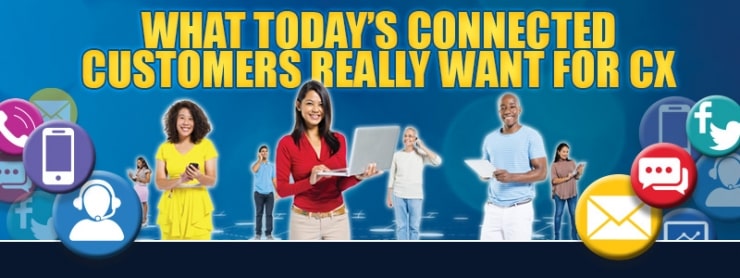
What Customers Really Want For Their Call Center Customer Experience
Today's connected customers expect to resolve their inquiry or problem on the first contact regardless of what contact channel they choose to use. This conclusion is based on SQM's research of benchmarking over 500 leading North American contact centers and conducting 7.5 million surveys with customers who used a contact channel to resolve an inquiry or problem. In fact, SQM research shows that 93% of customers using the call center channel and 72% of customers using the website channel expect to resolve their inquiry or problem in one contact.
The bottom line is that when the mission is to deliver a great contact center customer experience (CX) on any contact channel used by the customer, One Contact Resolution (OCR) is what today's connected customers really want for CX.
OCR is a more challenging metric to achieve than First Call Resolution (FCR) because OCR factors whether or not other channels were used, and FCR only factors in one channel being used. An alarming 42% of customers cannot resolve their inquiry or problem on the first contact for the average call center.
Given that only 58% of customers have an OCR experience, it should be viewed as a huge wake-up call for the contact center industry to measure the customer's entire experience (i.e., all contact channels used) trying to resolve the same inquiry or problem.
The following figure shows the most important to customers when interacting with an organization to resolve an inquiry or problem. It is essential to state that all these business practices can provide a great call center customer experience or contact center customer experience.
Figure: What is most important to customers when interacting with an organization
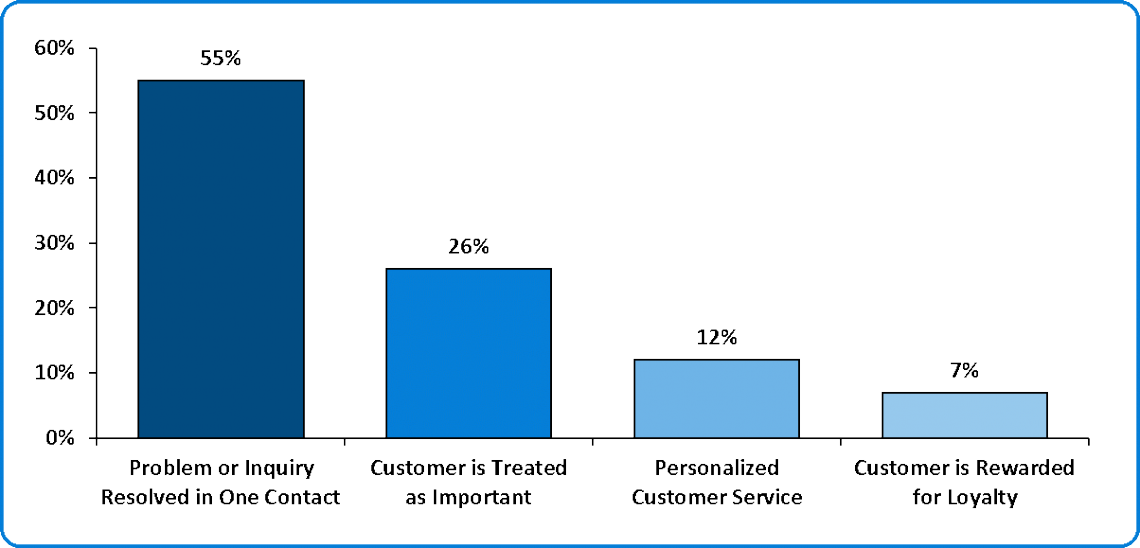
The four business practices that are most important to customers are as follows:
- Resolving an inquiry or problem in one contact is the most important business practice customers want to experience when using a contact channel. Organizations use many metrics to measure a customer's experience using a contact channel, such as customer satisfaction (Csat), sentiment scores, Net Promoter Score® (NPS®), ease of effort, and QA. These are all worthy metrics to use; however, since most customers want to resolve their inquiry or problem in one contact using only one channel, OCR must be measured.
- Treating the customer as being important to the organization. This can range from something as simple as an Agent telling the customer they appreciate the customer's business or going the extra mile to resolve their inquiry or problem.
- Providing personalized customer experiences such as offering needs-based products and services in real-time, extending special offers or coupons. Also, customized service when customers pay their bill online and subsequently call the organization to confirm payment, having the IVR automatically thank them for their bill payment and their business. As organizations provide more personalized service, they need to be aware that most customers are concerned with data security and privacy, so care must be taken when delivering personalized service.
- Showing customers appreciation by rewarding them for their loyalty to the organization. Customers like to be advised through an outbound contact channel (e.g., email or SMS) on what their loyalty to the organization has earned them, such as points, frequent flyer miles, or cash rewards.
The following figure shows CX's preference for contact channel service delivery practices. Of the four contact channels service delivery practices (i.e., One Contact Resolution, Omni-Channel CX, Seamless CX, and Non-Seamless CX), OCR is by far the preferred CX. After all, most customers who use a contact channel expect that their inquiry or problem will be resolved on the first contact using only one contact channel.
When the customer uses more than one contact channel to resolve the same inquiry or problem, the organization should provide a seamless CX. However, it is important to understand that even when the customer has a seamless experience, they might still be dissatisfied because they expected to have their inquiry or problem resolved on the first contact using only one contact channel.
The non-seamless service delivery practice should be eliminated or significantly reduced for all contact reasons. Some customers do not mind a non-seamless experience; however, they tend to be the exception. The bottom line is that the easier it is for a customer to resolve their inquiry or problem, the higher their Csat.
Figure: Channel usage CX preference
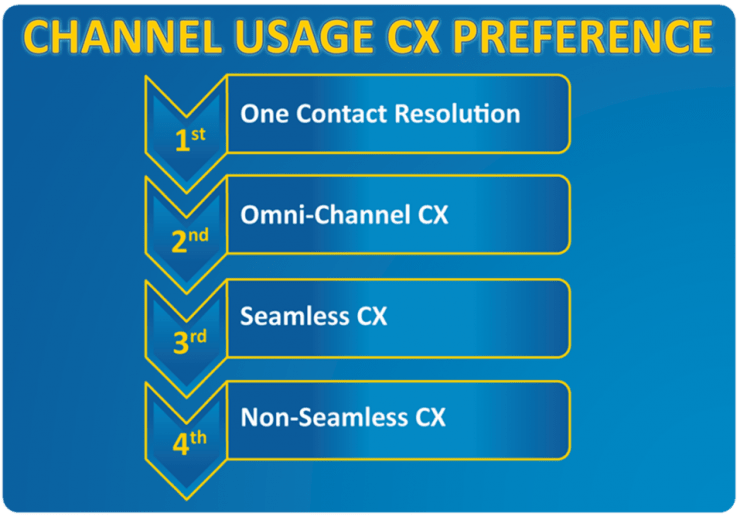
To help clarify the differences in contact channel service delivery practices, SQM has developed the following definitions:
- One Contact Resolution – A customer resolved their inquiry or problem in one contact using one channel.
- Omni-Channel CX – A customer had a seamless experience to resolve the same inquiry or problem across all contact channels. In addition, the customer was very satisfied (top box response) with their entire experience using multiple channels to resolve the same inquiry or problem.
- Seamless CX – A customer had a seamless experience to resolve the same inquiry or problem across all contact channels. In other words, when a customer used another channel to resolve the same inquiry or problem, they were easily able to pick up from where they left off in the previous channel and, as a result, did not have to start from the beginning. As a result, most of these customers will be satisfied; however, some will be dissatisfied because they had to use two or more contact channels.
- Non-Seamless CX – A customer did not have a seamless experience when using multiple channels to resolve the same inquiry or problem. In other words, the customer had to start their interaction from the beginning each time they used another channel to resolve the same inquiry or problem.
The following figure shows contact channel service delivery CX for OCR and multiple channel usage. Again, 58% of customers had an OCR service delivery CX when resolving an inquiry or problem, and 20% used two or more contact channels to resolve the same inquiry or problem.
Of the customers who used multiple channels to resolve the same inquiry or problem, 53% of customers had a non-seamless CX, which means the customer had to start their interaction from the beginning when they used another channel to resolve the same inquiry or problem.
This also means that 47% of customers had a seamless CX. However, only 29% of customers had an omni-channel CX, which means they had a seamless experience and were very satisfied when they used two or more contact channels to resolve the same inquiry or problem. In other words, customers were easily able to pick up from where they left off in the previous channel and, as a result, did not have to start from the beginning.
Figure: Contact channel service delivery CX
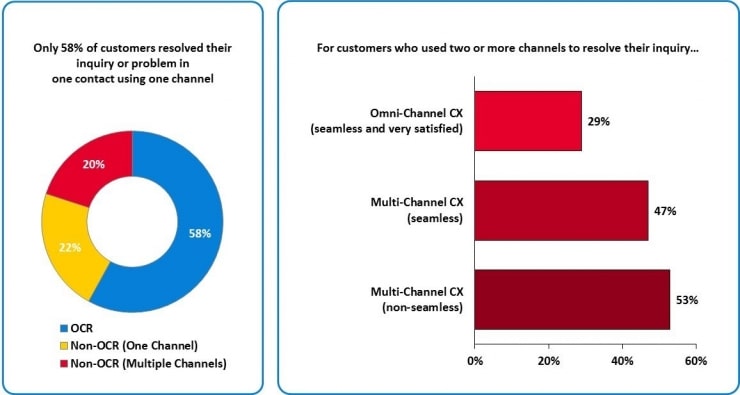
From SQM's perspective, few organizations know their customers' satisfaction when using specific contact channels (e.g., IVR self-service, mobile self-service, email, chat) or when using multiple contact channels to resolve the same inquiry or problem.
As a result, SQM is often asked, "What are the differences between OCR, seamless, and non-seamless CX from a Csat point of view?" For example, the following figure shows Csat (top box response) based on the contact channel CX for resolving a customer's inquiry or problem.
The main finding is that for a customer who uses two or more channels to resolve the same inquiry, Csat is 39% higher when it is a seamless experience than when it is a non-seamless experience.
The easier it is for a customer to resolve their inquiry or problem, the higher their Csat. That is the reason why the OCR practice, at 89% Csat, is the highest by far of all the contact channel customer experiences. On the other hand, the Csat for a seamless CX is 67% and for a non-seamless CX is 28%, which is the lowest of all contact channel customer experiences.
When customers use two or more channels to resolve their inquiry or problem, have a seamless experience, and are very satisfied with their multi-channel experience, it could be defined as a true omni-channel CX.
Figure: Csat based on contact channel CX
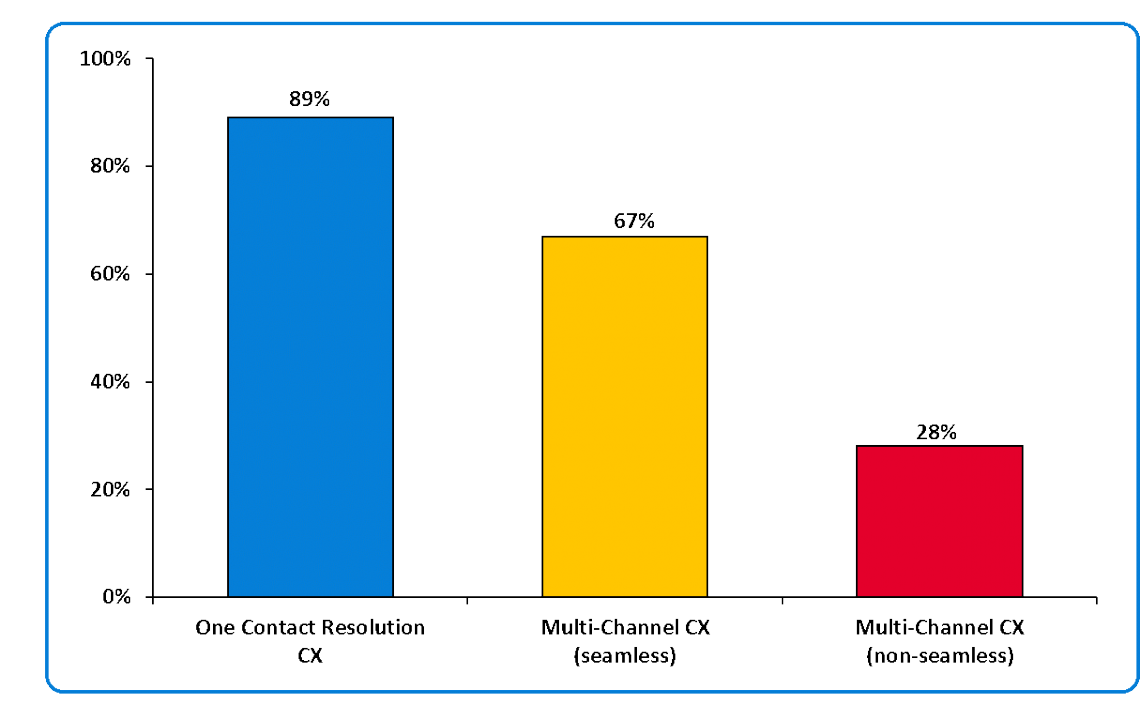
The following figure shows simultaneous channel usage. Of the customers interacting with an organization, 37% simultaneously use two or more contact channels to resolve an inquiry or problem. When customers use two channels simultaneously to resolve an inquiry or problem, 62% of the time, it is the combination of the web self-service and call center channels, which is by far the most popular combination of channels being used.
Figure: Simultaneous channel usage
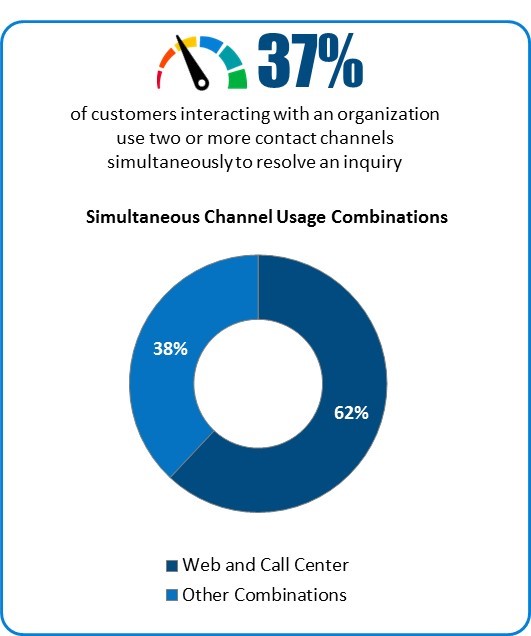
The following figure shows the usage for the combination of call center and another channel. For customers who used the call center, 20% of customers also used another channel to resolve the same inquiry or problem. Similar to simultaneous channel usage, the other contact channel was the website channel in most cases. Of those instances of multiple channel usage, 74% of customers used the other contact channel before calling the call center.
Given the high percentage of customers using the call center last when they used the combination of the call center and another channel, this underscores the view that the call center is the last line of defense for resolving an inquiry or problem. For example, 13% of customers simultaneously used the call center and another contact channel to resolve an inquiry or problem. However, the contact channel simultaneous usage for order call types is significantly higher than the 13% for inquiry and problem call types.
Figure: Combination of call center and another channel usage
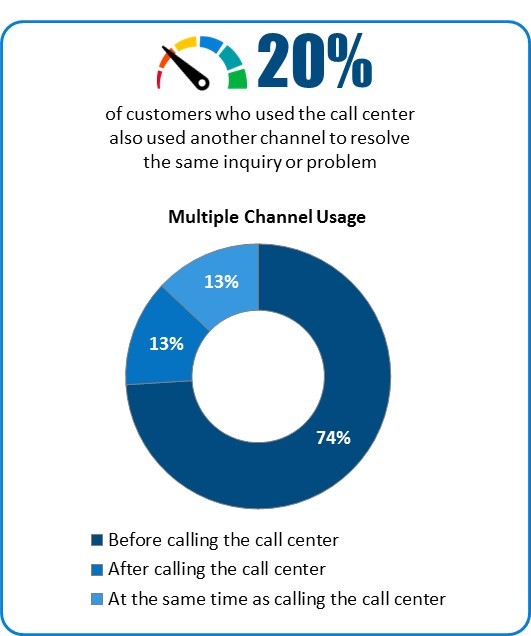
If you are interested in learning more about What Today's Connected Customers Really Want for CX to improve Csat, increase customer referrals, and retention, please contact SQM.
Quick Related Links
First Call Resolution Definition First Call Resolution PPT First Call Resolution Benefits
First Call Resolution Strategies First Call Resolution Operating Philosophy Resolution First Call Resolution Formula CX Expectations Top 10 CX Metrics One Contact Resolution Channel Hopping
